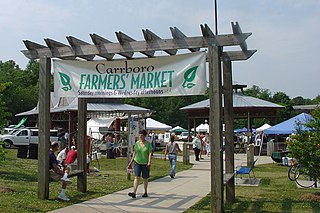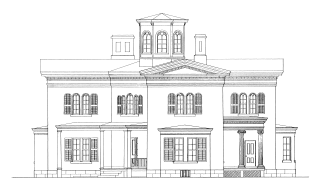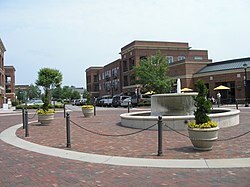
Chapel Hill is a town in Orange and Durham counties in the U.S. state of North Carolina. Its population was 61,960 in the 2020 census, making Chapel Hill the 17th-largest municipality in the state. Chapel Hill, Durham, and the state capital, Raleigh, make up the corners of the Research Triangle, with a total population of 2,106,463 in 2020 census.

The University of North Carolina at Chapel Hill is a public research university in Chapel Hill, North Carolina. It is the flagship of the University of North Carolina system and is considered to be one of the "Public Ivies". After being chartered in 1789, the university first began enrolling students in 1795, making it one of the oldest public universities in the United States.

Carrboro is a town in Orange County in the U.S. state of North Carolina. The population was 21,295 at the 2020 census. The town, which is part of the Raleigh-Durham-Chapel Hill combined statistical area, was named after North Carolina industrialist Julian Shakespeare Carr.

Cary is a town in Wake, Chatham, and Durham counties in the U.S. state of North Carolina and is part of the Raleigh-Cary, NC Metropolitan Statistical Area. According to the 2020 Census, its population was 174,721, making it the seventh largest municipality in North Carolina, and the 148th largest in the United States. In 2022, the town's population had increased to 180,388.
The Penland School of Craft is an Arts and Crafts educational center located in the Blue Ridge Mountains in Penland, North Carolina in the Snow Creek Township near Spruce Pine, about 50 miles from Asheville.

Cooleemee, also known as the Cooleemee Plantation House, is a house located between Mocksville and Lexington, North Carolina, at the terminus of SR 1812 on the Yadkin River in Davie County, North Carolina. It is a U.S. National Historic Landmark, designated in 1978 for its architecture.

Carr Mill Mall is a small, local shopping mall located in Carrboro, North Carolina. It is listed on the National Register of Historic Places as the Alberta Mill Complex. It is also a host for numerous local live performances and other cultural events.

The Orton Plantation is a historic plantation house in the Smithville Township of Brunswick County, North Carolina, United States. Located beside the Cape Fear River between Wilmington and Southport, Orton Plantation is considered to be a near-perfect example of Southern antebellum architecture. Built in 1735 by the co-founder of Brunswick Town, Colonel Maurice Moore, the Orton Plantation house is one of the oldest structures in Brunswick County. During its history Orton Plantation has been attacked by Native Americans, used as a military hospital, and been home to lawyers, physicians, military leaders, and a Colonial governor.

Bynum Hall is the current home of the University of North Carolina at Chapel Hill Graduate Admissions office and was the first home of North Carolina Tar Heels men's basketball team. At an executive meeting on October 2, 1903, it was revealed that school President Francis Preston Venable announced that former North Carolina Supreme Court justice William Preston Bynum donated $25,000 to have a gymnasium built in honor of his grandson who was a student at the university and had died due to typhoid fever. Architect Frank P. Milburn drafted plans for the structure, which were then approved by Bynum and the university's Board of Trustees. The building was designed to have a Greek architecture influence and had three stories with an above-ground basement. It originally contained a swimming pool, gymnasium. office spaces, and other rooms for various sports like boxing and fencing. Construction was expected to begin in mid-May, but construction was delayed because the company supplying the bricks were not organized. The building had started construction by June and had various target dates that were pushed back for undisclosed reasons and eventually the building was completed in February 1905.

The Carolina Inn is a hotel listed on the National Register of Historic Places on the campus of the University of North Carolina at Chapel Hill in Orange County, North Carolina, which opened in 1924. The Carolina Inn is a member of Historic Hotels of America, the official program of the National Trust for Historic Preservation.

The Nissen Building is a 283 ft 18-story skyscraper in Winston-Salem, Forsyth County, North Carolina, built in 1927. It was the largest building in the city, succeeding the Hotel Robert E. Lee, and the tallest building in North Carolina from 1927 to 1929, when it was succeeded by the Reynolds Building; all three buildings were in Winston-Salem. The Nissen Building was named to the National Register of Historic Places March 17, 1983, with a boundary increase in 2004 to include a one-story addition built in 1969. With the spire on top, its height is 102.1m.

Medway or the Medway Plantation is a plantation in Mount Holly, South Carolina within Berkeley County, South Carolina. It is about 2 mi (3.2 km) east of U.S. Route 52 from the unincorporated community of Mount Holly, which is directly north of Goose Creek, South Carolina. It was named to the National Register of Historic Places on July 16, 1970.

Egg Rock Light is a lighthouse on Frenchman Bay, Maine. Built in 1875, it is one of coastal Maine's architecturally unique lighthouses, with a square tower projecting through the square keeper's house. Located on Egg Rock, midway between Mount Desert Island and the Schoodic Peninsula, it is an active aid to navigation, flashing red every 40 seconds. The light was listed on the National Register of Historic Places as Egg Rock Light Station in 1988.

The Pfau–Crichton Cottage, best known as Chinaberry, is a historic cottage in Mobile, Alabama. The 1+1⁄2-story, wood-frame, Gulf Coast cottage was completed in 1862. The house was built by the Pfau family, but its best known resident was Miss Anne Randolph Crichton, known for the elaborate gardens that she developed on the property. She enlisted in the Navy at the outbreak of World War I and continued her service until retirement, in the 1950s. She traveled extensively in Europe during the 1930s, maintaining scrapbooks that recorded her visits to various art museums, gardens, and monuments. She was the last direct descendant of Hugh Randolph Crichton, the founder of the Mobile County town of Crichton. The house was added to the National Register of Historic Places on October 18, 1984, as a part of the 19th Century Spring Hill Neighborhood Thematic Resource listing of well-preserved buildings that represent the historical development of what was once the village of Spring Hill.

The DuBose Conference Center, formally known as the DuBose Memorial Church Training School, is a historic site and former conference center associated with the Episcopal Church at Fairmont and College Streets in Monteagle, Tennessee. It was historically an Episcopal Church training and conference center. On April 29, 2023, the conference center permanently ceased operations when the Episcopal Diocese of Tennessee deconsecrated the property. The mission of DuBose Conference Center was to "offer hospitality, programming, and sacred space to groups of all faiths and backgrounds for education, creativity, and renewal."
Richard Sharp Smith was an English-born American architect, associated with Biltmore Estate and Asheville, North Carolina. Clay Griffith with the North Carolina State Historic Preservation Office says, "The influence of Richard Sharp Smith’s architecture in Asheville and western North Carolina during the first quarter of the twentieth century cannot be overstated." His vernacular style combines elements of Craftsman, Colonial Revival, English cottage, Shingle, and Tudor Revival architectural styles. He is associated with some of America's important architectural firms of the late 19th century—Richard Morris Hunt, Bradford Lee Gilbert, and Reid & Reid.

The Crabtree Jones House, also known historically as the Nathaniel Jones Jr. House, is a residence at 3108 Hillmer Drive in Raleigh, North Carolina. Constructed around 1808-1811 by Nathaniel Jones, it is one of the few remaining large scale plantation homes in Wake County, and one of the oldest private residences in Raleigh. The home has received several additions since its initial construction, but is mainly known for its Federal-style front. Owned by the Jones family for more than 150 years, the house has fallen into disrepair in more recent decades. Following the purchase of the land the house sat upon by developers in 2012, Preservation North Carolina acquired the house and had it moved to a nearby residential neighborhood, where it sits today. The Crabtree Jones house was greatly influenced by the historical events it stood through while in turn influencing the way the Raleigh community developed around it, through both its people and through its land.

Young Men's Institute Building, also known as the YMI Building, is a historic meeting hall located at Asheville, Buncombe County, North Carolina. It was designed by architect Richard Sharp Smith and built in 1892–1893. It is a 2+1⁄2-story, pebbledash coated masonry building with brick, stone, and wood accents. From its early days, the YMI building has housed shops, residence rooms, meeting rooms, and a wide variety of functions serving the African American community of Asheville. The building was restored and reestablished as the YMI Cultural Center in 1980, and now hosts a variety of intercultural programs and events. It is located in the Downtown Asheville Historic District.

The Wilkins House is a historic house in Greenville, South Carolina, built in 1878 by Jacob W. Cagle (1832–1910) for merchant and capitalist William T. Wilkins (1825–1895). It was listed on the National Register of Historic Places on July 19, 2016.

The Arthur C. and Mary S.A. Nash House is a historic home in Chapel Hill, North Carolina, located at 124 South Boundary Street.























